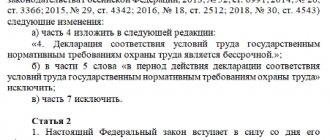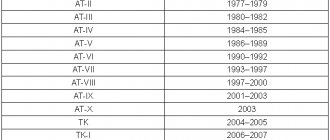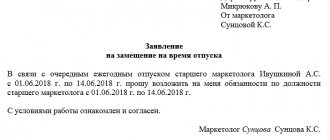Relocating a worker
This concept is explored in Chap. 12 of the Labor Code of the Russian Federation, which is devoted to all legal nuances related to changes in employment contracts. According to Art. 72.1 of the Labor Code of the Russian Federation, these signs of movement are that:
- to implement it, you do not need to change the employment contract or enter into a new one;
- movement can only be carried out within the area where the person’s labor activity was carried out;
- the employee does not change employer ;
- relocation is carried out when changing structural divisions of the organization;
- movement occurs when changing mechanisms and units on which labor activities are carried out.
To better understand the essence of movement, it is necessary to conduct a comparative analysis of the two phenomena described in Art. 72.1 Labor Code of the Russian Federation.
Transfer to a lower paid position
The need to provide a position where the salary will be lower arises if the situation is as follows:
- In the process of downsizing. This situation occurs when, due to economic necessity, there is a change in staffing in which a position is eliminated.
- When the number is reduced, the position remains, but the number of those working in it is reduced. In this case, some employees are fired. This process is regulated by the Labor Code. Before dismissal, the boss should prepare for them a job that will suit them. In certain situations, we may be talking about a lower-paid position.
- When downtime occurs, the person is transferred by decision of the director for no longer than one month.
- Sometimes a change to a lower salary may be due to health conditions. This is possible if the employee is not able to do what he did before at a good level.
When such a step is taken by agreement of both parties and consent has been expressed, recorded in the appropriate document.
An employee can express consent to perform lower-paid work in situations where he needs it for some reason. For example, he wants to have more free time or a job with fewer duties or responsibilities.
Similarities and differences
The labor process in any, even the smallest, institutions is a very dynamic phenomenon. This especially applies to organizations engaged in manufacturing and services.
Transfer and relocation are necessary for the employer because employees must be located where the company needs them most at the moment. However, similar dynamics are also needed by the employee, because transfers and relocations raise the level of qualifications and demand for this specialist. The main differences between translation and displacement are as follows:
- A permanent transfer changes the working conditions fixed in the contract, so such an action requires the conclusion of a new contract or amendments to the old one . Relocation , if it really is such, does not change working conditions .
- When transferring, an employee can be moved not only in space. Often this procedure leads to the person taking a new position . So the transfer can be carried out with a promotion, demotion or without a change in the official position of the employee. A move is never associated with a change in position . The only change of this nature is the possible renaming of the position, which does not in any way affect the amount of the salary or the set of competencies that the employee must have.
- Under movement, as follows from Art. 72.1 para. 3 of the Labor Code of the Russian Federation, is understood as an order in relation to a subordinate employee to carry out his work activities in another structural unit, on other equipment, using other equipment . Such an order can most often be given by the employer. However, any official who has the appropriate administrative powers can move workers due to production needs. Such movements should not contradict the terms of the concluded agreement . Otherwise, it will no longer be a movement, but a translation.
- When transferring, an order is issued and an entry is made in the work book. Relocation carried out in accordance with the requirements of the law is carried out in accordance with the notification procedure . In this case, the boss simply informs the subordinate that tomorrow he will go to another workshop to do the same work. Relocation is also possible with the issuance of an order if, for example, a change in the structure of the enterprise is made, when, in connection with the liquidation of a structural unit, employees are moved in the same capacity to another unit.
The fundamental difference between transfer and relocation is the need to change the employment contract.
Comparison
A permanent transfer of an employee is always documented in the work book, while a transfer does not require such an entry. It is possible to separate one type of movement from another only by studying the employment contract. This affects the actual assessment of a legally significant action. When transferring, an additional agreement is always concluded with the employee, which stipulates the essential conditions of the activity.
Both movement and transfer cannot be carried out if it is dangerous to the person’s health. The larger the organization, the more opportunities it has for horizontal and vertical movement of labor resources. Very often, personnel services use such a technique as terminating the old contract and preparing a new one. This is due to their reluctance to enter into additional agreements between the parties to the labor relationship.
Decor
Since the employee’s consent to the move is not required , his objections in this regard are not taken into account. However, objections may vary.
For example, what should you do if an employee of a construction company is transferred to another nearby facility in the same capacity and with the same working conditions, but the employee himself does not go to the new facility, but comes to work at his old place of work?
- You will have to issue an order or written order to move . A copy of the order or instruction must be given to the employee, forcing him to sign on the original after the word “acquainted”. If the employee refuses to participate in such a procedure, then a statement of refusal is drawn up, which is signed by three witnesses.
- If the next day after familiarization, an employee returns to his previous place of work, an explanatory note .
- Further actions of management depend on what is written in the explanatory note. For example, reluctance to join another work team cannot be recognized as a valid reason, so further persistence of the employee is fraught with disciplinary action. If the note provides an argument that the conditions at a given facility are incompatible with the employee’s health (allergies, the need to climb stairs, etc.), then management will have to abandon their intentions. Otherwise, a further meeting of the parties may take place in court.
If an employee refused to go to a new place of work due to a low level of labor safety, which was reflected in his explanatory note, and an accident occurred at his new place of work, then all responsibility falls on the management of the enterprise.
And then transfers and movements can be considered in other instances. In Art. 227 of the Labor Code of the Russian Federation there is no mention of the peculiarities of considering accidents that occurred during the movement of workers . This is due to the fact that the displaced worker is subject to all regulations related to accidents that occur at work or while traveling to and from work. However, there are some nuances.
If the employee was transferred from one equipment to another with different characteristics. In this case, such workers must be given new safety training when working with this particular equipment.
If instruction was not carried out and an accident occurred, then the person responsible for labor safety is to blame.
There is another version of the ambiguous situation. If, after a verbal order to move to another facility or place of work (another workshop, office, premises), a person is injured, then consideration of the issue of guilt and compensation depends on whether the manager confirms the fact of his order or not. If the order is in writing, an accident when moving to a new facility is clearly considered an industrial accident with all the ensuing consequences.
Types of transfers
The legislator determined that the transfer of an employee at an enterprise can be temporary or permanent. Temporary transfer is permitted in cases provided for by law. First of all, these are various incidents of a man-made or natural nature, under force majeure circumstances, etc. That is, when the situation specifically requires the presence of the employee at another place of work.
The period of temporary transfer cannot exceed one year. This is the maximum period. Temporary transfer is often used for health reasons. For example, an employee may need to be transferred to another position or department at the insistence of doctors.
The duration of such a transfer does not exceed 4 months. If the employer does not have a job suitable for him, then he is obliged to remove the employee from performing labor functions and maintain his place of work. Dismissal in this case is illegal.
Temporary transfer to another job for a period of more than 4 months due to health reasons also implies that the employer is obliged to provide such work. If the employer does not have such an opportunity, then the only option is to fire the employee. Temporary transfer to another job during a woman’s pregnancy is also quite popular. The employer is obliged to transfer pregnant employees to easier and safer work while maintaining their wages.
The second type of transfer is permanent. And, as mentioned above, this could be a change of job function within one organization, work in another area, etc. And not in all these cases, the employee has the right to refuse without any consequences. For example, a transfer between structural departments of one enterprise implies the refusal of the employee. In other cases, if he refuses, he may be fired. And such a dismissal will be absolutely legal.
Entry into the work book
For HR specialists who are required to fill out work books, the main guide to action is the “Instructions on the procedure for maintaining work books...”, approved back in 1974, but edited in 1990. There is no mention of displacement in Chapter 2 of this document.
Entries in work books are made only when:
- hiring or dismissal;
- permanent transfer within a given organization or to another organization;
- incentives and changes in the professional qualities of an employee (retraining, increase in grade, etc.).
When an employee moves within the same institution, an entry about this is not made in the work book.
In case of temporary transfer, no entry is made either. This is the logic of the official instructions. However, there is one caveat. During the structural reorganization of an institution, strange situations often arise.
For example, what to do if a department is liquidated and its employees are moved to another with the same responsibilities and working conditions? After all, in accordance with the entry in the work book, these people are listed in a non-existent unit.
The way out of this situation is very simple - an entry is made in the employee’s personal card . However, there is an exception to this rule.
If a person transferred to another unit acquires new benefits (for example, early retirement, the right to additional treatment), then in this case an entry is made in the work book, but always with a description of the nature of the work.
Ban
The Labor Code does not establish any conditions that would prevent the transfer of an employee. It is possible, however, based on the provisions, to imagine a situation where an employee has any medical restrictions on health, confirmed by the relevant document
. And this circumstance prevents him from working, for example, at another workplace or with another unit. The practical application of the provisions of this article, however, is not a reason for dismissal.
Therefore, you should familiarize yourself with the employee’s personal file before issuing an order to move him. Perhaps his health does not allow him to work in new conditions.
It is always better to find a compromise between the interests of the employee and the employer. If an employee is upset about his transfer, then no legal provisions will force him to work with full dedication. The atmosphere in the team should be protected.
The movement of an employee within one enterprise is an integral part of his career. All stages of an employee’s movement along the job ladder are expressed in transfers from one position to another and movements from one place to another. In some cases, his consent is mandatory, in others it is not required at all. At the same time, both the employer and the employee of the enterprise must carefully monitor the correct execution of documents, since their rights and significant interests depend on this.
Let's look at examples
In order to understand the difference between translation and movement, let's look at some examples:
- In the field of education, such phenomena as part-time work, combination, transfer and relocation are common. For example, a new department is created at a university, which is somewhat similar in topic to the old one, but still has its differences. Several employees from the old department write an application to enroll them in the staff of the new department. If the qualifications of these employees fully meet the requirements for employees of the new department, then their transition is actually a relocation . If a department teacher transfers to the university management apparatus, then this action should already be formalized as a transition.
- If, within a large company that has subsidiaries, one of the enterprises is liquidated, and it is decided to transfer some employees to other enterprises, then this action is carried out as part of the transfer. There are several arguments here: moving to another locality, changing the conditions and nature of work. However, the main argument that this is a transfer and not a relocation is that, despite belonging to the same company, people work in different enterprises and report to different employers. And a change of employer is an unambiguous sign of a transfer, not a relocation .
- If a cleaner of any institution is forced to work as a janitor on the street while maintaining the same salary, then in any case this must be qualified as a transfer and not a transfer, because the specifics and working conditions of a janitor are significantly different from the work of a cleaner .
Conclusions TheDifference.ru
- Essential terms of the agreement. When translated they change, when moved they remain the same. Thus, the first type of movement may require special skills, education and qualifications, but the second type definitely does not.
- Labor function. When moving to a new position, it remains the same; when transferred, it changes.
- Terrain. The movement of an employee involves movement in the same locality. A transfer may involve moving to a new city, which is essential for the vast majority of employees.
- Employee consent. In all cases of transfer, the consent of the enterprise employee is required. Movement does not require such an expression of will, since in fact horizontal rather than vertical movement is carried out.
The difference between translation and displacement
To avoid problems with regulatory authorities, it is important to know the difference between transfer and relocation in terms of carrying out the necessary personnel procedures.
A commercial organization is an integral system within which constant movement occurs. New employees are hired, “old-timers” decide to leave the company, management promotes specialists, assigns them to related positions, and looks for replacements for employees on vacation or sick leave. Each rearrangement requires appropriate documentation.









